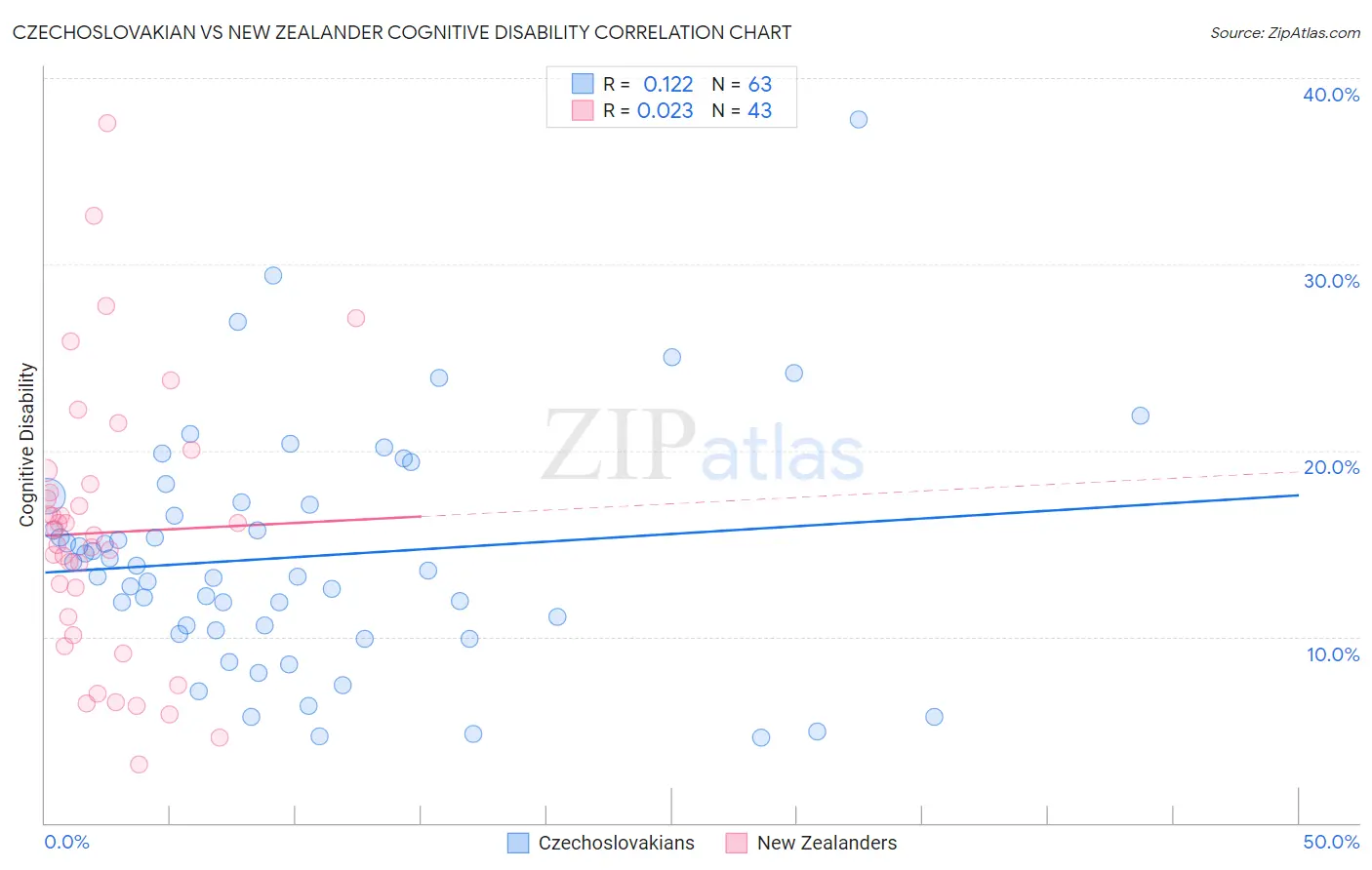Czechoslovakian vs New Zealander Cognitive Disability
COMPARE
Czechoslovakian
New Zealander
Cognitive Disability
Cognitive Disability Comparison
Czechoslovakians
New Zealanders
16.6%
COGNITIVE DISABILITY
99.6/ 100
METRIC RATING
62nd/ 347
METRIC RANK
17.4%
COGNITIVE DISABILITY
21.1/ 100
METRIC RATING
195th/ 347
METRIC RANK
Czechoslovakian vs New Zealander Cognitive Disability Correlation Chart
The statistical analysis conducted on geographies consisting of 368,659,789 people shows a poor positive correlation between the proportion of Czechoslovakians and percentage of population with cognitive disability in the United States with a correlation coefficient (R) of 0.122 and weighted average of 16.6%. Similarly, the statistical analysis conducted on geographies consisting of 106,922,503 people shows no correlation between the proportion of New Zealanders and percentage of population with cognitive disability in the United States with a correlation coefficient (R) of 0.023 and weighted average of 17.4%, a difference of 5.1%.

Cognitive Disability Correlation Summary
| Measurement | Czechoslovakian | New Zealander |
| Minimum | 4.6% | 3.1% |
| Maximum | 37.8% | 37.6% |
| Range | 33.2% | 34.5% |
| Mean | 14.3% | 15.6% |
| Median | 13.6% | 15.4% |
| Interquartile 25% (IQ1) | 10.4% | 10.1% |
| Interquartile 75% (IQ3) | 17.2% | 18.2% |
| Interquartile Range (IQR) | 6.9% | 8.2% |
| Standard Deviation (Sample) | 6.3% | 7.4% |
| Standard Deviation (Population) | 6.3% | 7.3% |
Similar Demographics by Cognitive Disability
Demographics Similar to Czechoslovakians by Cognitive Disability
In terms of cognitive disability, the demographic groups most similar to Czechoslovakians are Argentinean (16.6%, a difference of 0.020%), Immigrants from England (16.6%, a difference of 0.030%), Venezuelan (16.6%, a difference of 0.080%), Romanian (16.6%, a difference of 0.090%), and Pennsylvania German (16.6%, a difference of 0.10%).
| Demographics | Rating | Rank | Cognitive Disability |
| Immigrants | Venezuela | 99.7 /100 | #55 | Exceptional 16.5% |
| Austrians | 99.7 /100 | #56 | Exceptional 16.6% |
| Bhutanese | 99.7 /100 | #57 | Exceptional 16.6% |
| Pennsylvania Germans | 99.7 /100 | #58 | Exceptional 16.6% |
| Immigrants | Peru | 99.7 /100 | #59 | Exceptional 16.6% |
| Romanians | 99.7 /100 | #60 | Exceptional 16.6% |
| Immigrants | England | 99.6 /100 | #61 | Exceptional 16.6% |
| Czechoslovakians | 99.6 /100 | #62 | Exceptional 16.6% |
| Argentineans | 99.6 /100 | #63 | Exceptional 16.6% |
| Venezuelans | 99.6 /100 | #64 | Exceptional 16.6% |
| Colombians | 99.6 /100 | #65 | Exceptional 16.6% |
| Immigrants | Ukraine | 99.5 /100 | #66 | Exceptional 16.6% |
| Latvians | 99.5 /100 | #67 | Exceptional 16.6% |
| Ukrainians | 99.4 /100 | #68 | Exceptional 16.6% |
| Immigrants | Uzbekistan | 99.4 /100 | #69 | Exceptional 16.7% |
Demographics Similar to New Zealanders by Cognitive Disability
In terms of cognitive disability, the demographic groups most similar to New Zealanders are Immigrants from Bosnia and Herzegovina (17.4%, a difference of 0.040%), Guyanese (17.5%, a difference of 0.16%), Delaware (17.4%, a difference of 0.18%), Immigrants from Afghanistan (17.5%, a difference of 0.20%), and Immigrants from Haiti (17.4%, a difference of 0.23%).
| Demographics | Rating | Rank | Cognitive Disability |
| Immigrants | France | 29.8 /100 | #188 | Fair 17.4% |
| Immigrants | Western Asia | 29.5 /100 | #189 | Fair 17.4% |
| Immigrants | Spain | 27.7 /100 | #190 | Fair 17.4% |
| Immigrants | Nonimmigrants | 27.4 /100 | #191 | Fair 17.4% |
| Immigrants | Haiti | 27.1 /100 | #192 | Fair 17.4% |
| Delaware | 25.6 /100 | #193 | Fair 17.4% |
| Immigrants | Bosnia and Herzegovina | 22.0 /100 | #194 | Fair 17.4% |
| New Zealanders | 21.1 /100 | #195 | Fair 17.4% |
| Guyanese | 17.5 /100 | #196 | Poor 17.5% |
| Immigrants | Afghanistan | 16.7 /100 | #197 | Poor 17.5% |
| Immigrants | Panama | 14.8 /100 | #198 | Poor 17.5% |
| Immigrants | Singapore | 14.3 /100 | #199 | Poor 17.5% |
| Haitians | 14.1 /100 | #200 | Poor 17.5% |
| South American Indians | 13.0 /100 | #201 | Poor 17.5% |
| Immigrants | Morocco | 12.0 /100 | #202 | Poor 17.5% |